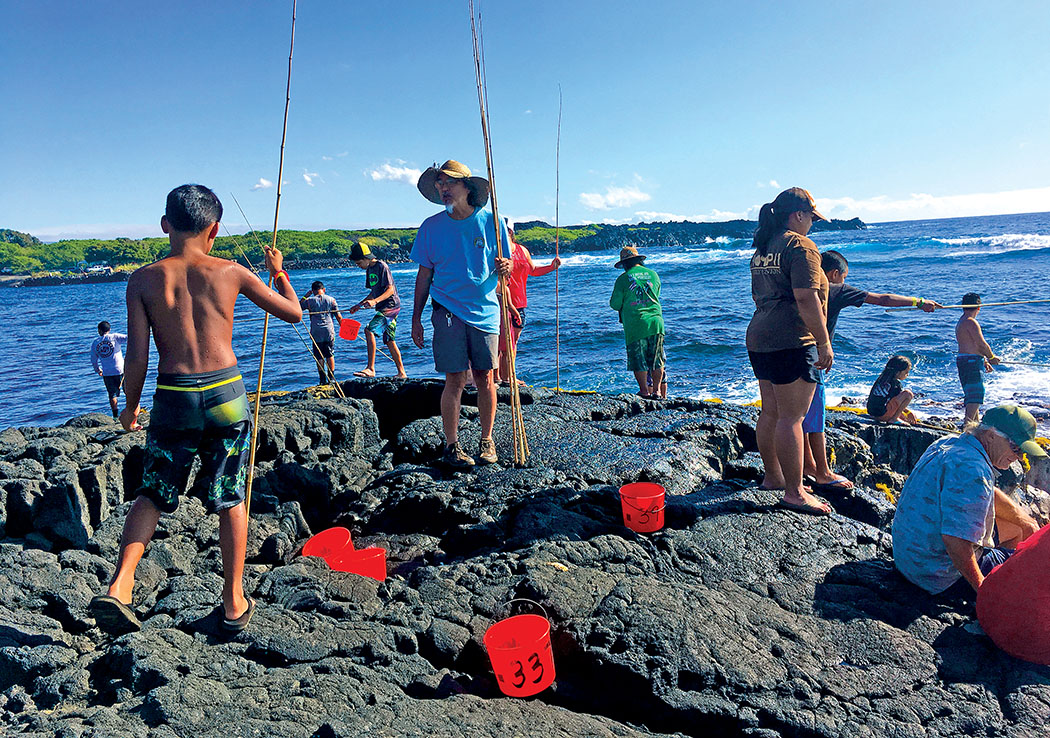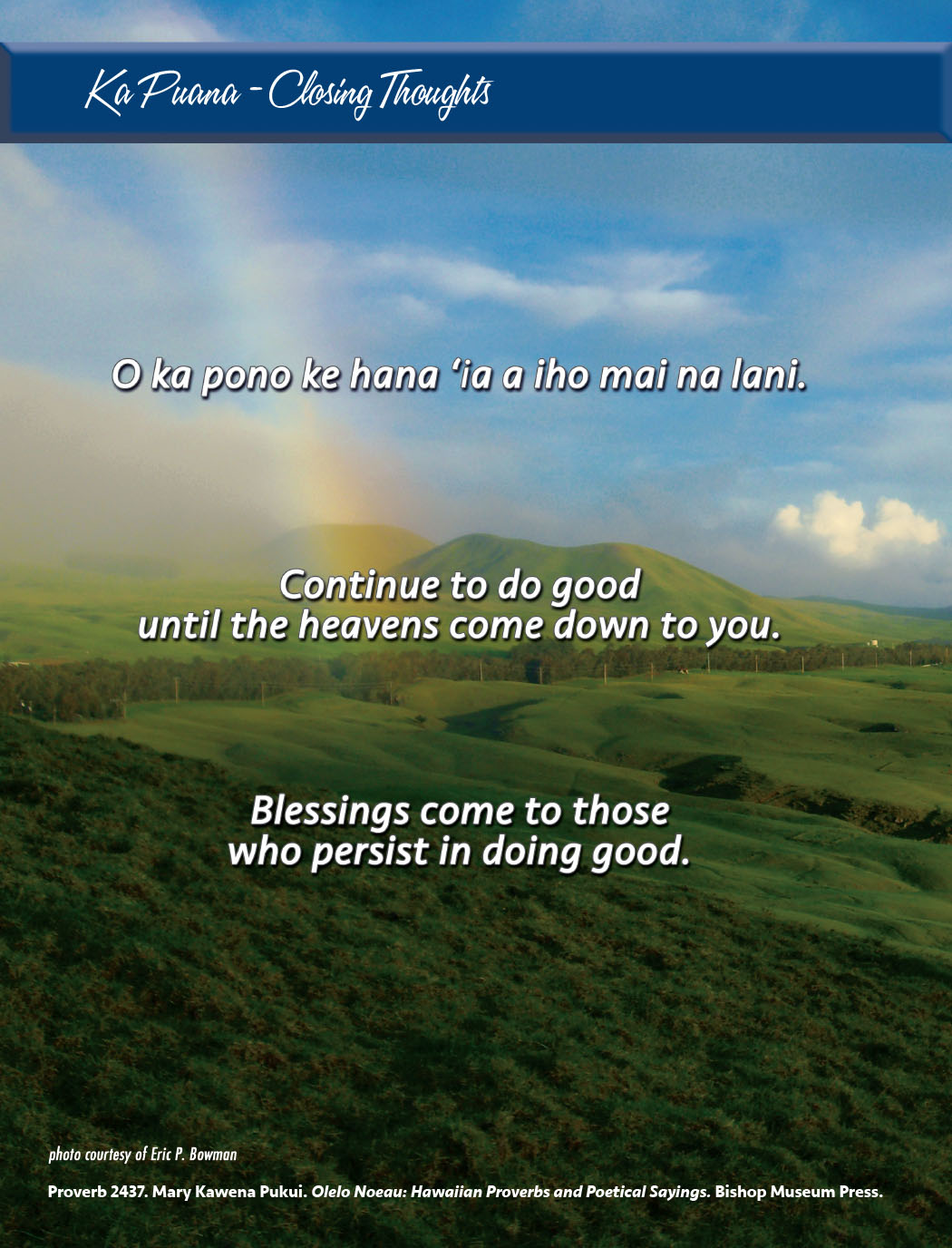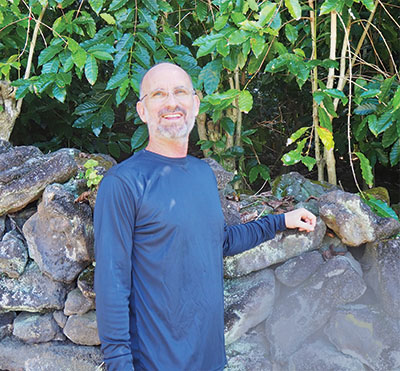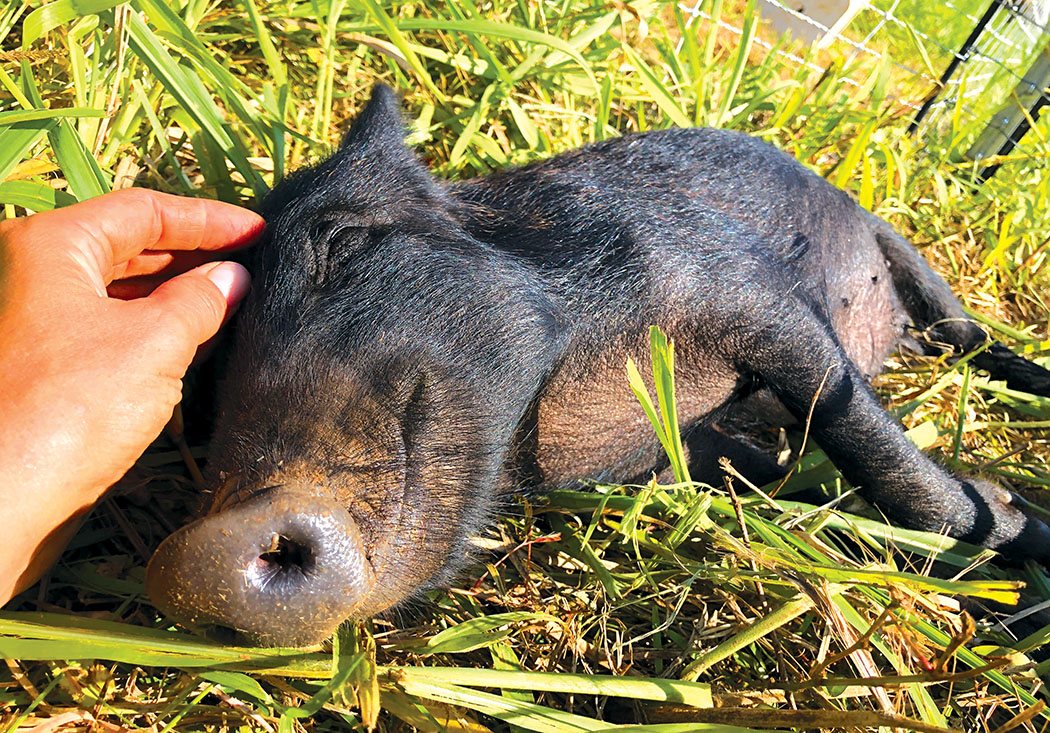
Magical Creatures of Hamakua: A Second Chance at Life for Animals Large and Small
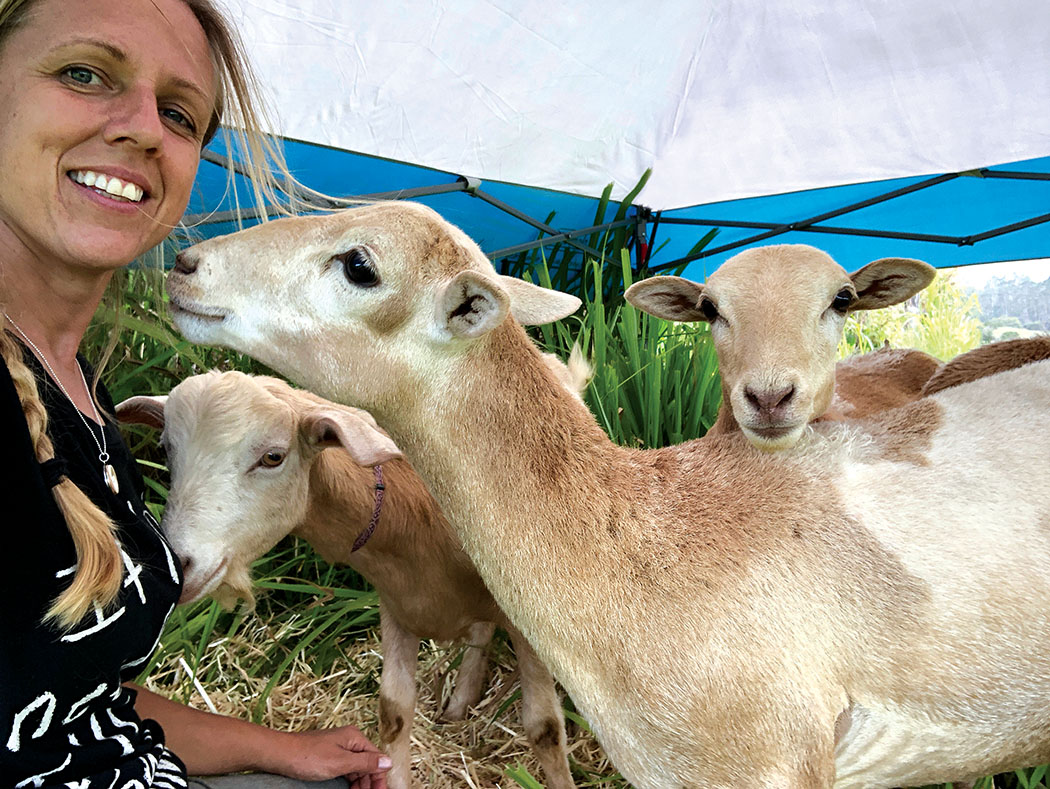
By Denise Laitinen
Standing atop a hill in the middle of a large green pasture along the Hāmākua Coast, the Pacific Ocean extends far into the distance melding with the blue sky as birds sing and puffy white clouds float by. Helena Lundblad calls out to her charges in Swedish and soon we are surrounded by a small herd of goats. “The animals respond to calls in Swedish and English,” explains Helena. It’s not a scene out of a Disney movie; rather, it’s a day in the life of Helena Lundblad, founder of Magical Creatures of Hamakua animal rescue and sanctuary.
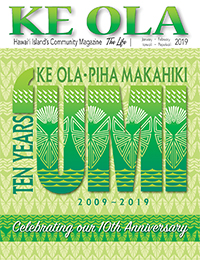
As we stand in the middle of a large field, Helena calls to each of the goats by name with monikers like Julie, Bruce, Daisy, Estelle, and Babette, the leader goat. We can see the horses graze in a pasture below and the sheep in yet another pasture. Some of the animals have special needs; some are orphans. All are friendly and love attention.
Helena knows them all by name and introduces them as they approach. On the other side of the field a cow raises her head from grazing to see what’s going on. Once the four-legged residents realize my camera is not food, they mosey on and start eating the grass around them.
A life-long animal lover, Helena created the animal sanctuary for farm animals in January 2018 with the idea of growing the animal rescue program slowly. That all changed in May 2018 when lava started erupting in lower Puna, forcing the evacuation of thousands of residents and farmers along with their pets and livestock.
It Started with a Love of Animals
Helena’s journey as caretaker to dozens of orphaned and injured farm animals in Hawai‘i actually started half way across the world in her native Sweden.
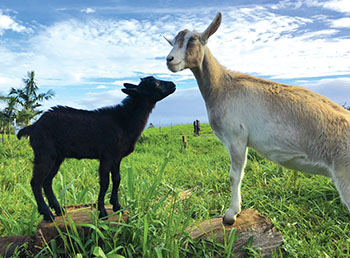
“I was always drawn to our non-human friends, and basically grew up in a horse stable,” says Helena. “In Sweden I was used to wide open spaces.” After meeting Mathias, now her husband, she relocated to San Diego, where Mathias worked in the airline industry and she worked as a flight attendant.
“In San Diego, I realized how much I missed having animals in my life, because where we lived we couldn’t have any pets.”
Her husband accepted a job with a local airline and was commuting between San Diego and Hawai‘i. By July 2016, they were both tired of the crowded city and the couple moved to Hawai‘i Island, settling on a 13-acre property along the Hāmākua Coast in Laupāhoehoe. Initially, Helena continued working as a flight attendant based in San Francisco, but soon gave up her job when the commuting got to be too much.
“When we moved here two years ago I didn’t have a sanctuary in mind,” says Helena, “but I knew I wanted to have animals around me.” Within weeks of moving into their house, the couple adopted two cats and a dog.
“There were six cows on property when we moved here,” says Helena, explaining that the previous landowner had let a rancher graze cattle on the property. “There’s 13 acres with a lot of grass, so we let him keep the cows here for a while. Then the cows’ owner came and took the cows away.”
It was a turning point for her and Mathias because, Helena says, “We realized we didn’t want to get attached to animals and then see them go to slaughter.” The couple started thinking of different opportunities they could explore with the land, like horse boarding, since they still needed animals to graze all the grass on the expansive rural property.

Janice the Goat
Then Janice the goat arrived. The infant orphan goat was only days old with severely burned hooves when Helena adopted her.
“Janice was my first rescue. She moved in when she was less than a week old,” says Helena. “Up until then I had never had a farm-type animal under my care before, only the more ‘normal’ cats, dogs, horses, bunnies, etc.
“Janice’s special needs and inability to walk made us grow a very close friendship. She lived in the house for six months and was with me pretty much all the time, on my arm or in a cat bed next to me, while she was healing from her injuries.
“That’s when my love for goats was born. They are amazing animals,” adds Helena with a smile. She even had two prosthetics made for the young goat enabling Janice to have more mobility. The young goat has become something of a sensation at the sanctuary and even has her own Instagram account (@janice_the_kid).
After that, Helena started fostering two horses for the Hawaii Island Humane Society.
“All of a sudden I kind of had a sanctuary, even though I didn’t officially have one, so it just made sense to incorporate.”
Helena formally launched Magical Creatures of Hamakua as a 501c3 nonprofit animal rescue and sanctuary. At the time she had two horses, three goats, and two piglets. The plan was to build the sanctuary slowly.
The Lava Eruption
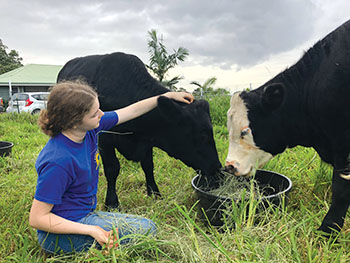
In early May, just months after starting the sanctuary, lava started erupting in the Lower East Rift Zone, devastating the communities of lower Puna, a rural district full of farms. The lava eruption destroyed more than 700 homes, forcing local residents to flee their homes and farmers to scramble to save their livestock.
As one of the few animal rescue sanctuaries on Hawai‘i Island with space to handle large animals, Helena opened the doors for animals that had to be evacuated. Nearly overnight, the Magical Creatures of Hamakua more than doubled its number of inhabitants.
Between the existing animals at the sanctuary, the lava evacuees, and the foster animals they receive from the Hawaii Island Humane Society, Magical Creatures has now grown to 47 animals.
Helena applied for grant funding for fencing and with the help of volunteers was able to fence in portions of the property to accommodate the new residents. Every detail of the animalsʻ welfare is taken into consideration. For instance, they have to use fencing with less spacing between the wires, so that goats with horns don’t get their heads stuck in the fences.
With the influx of animals, volunteers offered to lend a hand, rotating days. Helena does not draw a salary from the sanctuary and says she is grateful for her husband’s support and the team of volunteers that help out. “All the animals need attention every day,” adds Helena.
The bonds of friendship extend beyond that of human to animal. Some of the animals have also become best friends. Last year Magical Creatures of Hamakua took in a goat they named Tom. The young goat has many health issues, including that he is nearly blind. Janice, the goat with the two prosthetic legs, and Tom quickly became the best of friends and Janice acts as Tom’s seeing eye goat, leading him around.
Although the animals can move freely between some of the pastures, some of the livestock are kept in separate areas. Helena explains that each of the animal breeds have different nutritional needs. “The sheep and goats are in different pastures,” explains Helena. “While they both eat hay and graze in the fields and both eat salt licks, they have very different mineral needs. For goats, it is very important that they get copper, and for sheep, copper is toxic. Cows on the other hand, eat the cane grass in the fields while the horses eat alfalfa.”
For the pigs, Helena gets food scraps donated from a nearby restaurant and also feeds them pet pig feed.
Many of the animals have health issues, like one of the horses who has joint issues in his legs. Some of the older animals need senior food. Neither vet care nor food is cheap—food alone costs about $800 a month. The sanctuary primarily relies on donations and Helena has been fortunate to receive a few grants in their first year of operation.

Future Educational Programs
As Helena reflects on an incredibly busy 2018, she keeps her eye on future plans for the animal sanctuary. “I’d love to have school kids here to see how special the animals are,” she says. “I definitely believe we have to teach kids how to show compassion to create a better world. I’m excited for the future and hope I will be able to inspire change in the way people see these animals. They all have their unique personalities, their little secrets, and their touch of magic. I work long unpaid hours; I’m always muddy and probably slightly stinky. There’s no such thing as days off. But I have honestly never been happier! I love it here and I can’t imagine anywhere else I’d want to be.”
The sanctuary is currently closed to the general public, since it is just Helena and her husband with a small team of volunteers to care for all the animals. They are always looking for more help, though, and encourage people to contact them about volunteering. ❖
Photos courtesy of Magical Creatures of Hamakua
For more information: magicalcreaturesofhamakua.org
